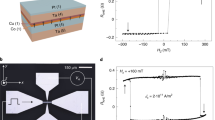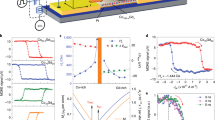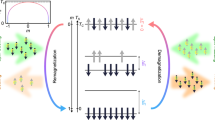Abstract
The discovery of spin-transfer torque (STT) enabled the control of the magnetization direction in magnetic devices in nanoseconds using an electrical current. Ultrashort optical pulses have also been used to manipulate the magnetization of ferrimagnets at picosecond timescales by bringing the system out of equilibrium. So far, these methods of magnetization manipulation have mostly been developed independently within the fields of spintronics and ultrafast magnetism. Here we show optically induced ultrafast magnetization reversal taking place within less than a picosecond in rare-earth-free archetypal spin valves of [Pt/Co]/Cu/[Co/Pt] commonly used for current-induced STT switching. We find that the magnetization of the free layer can be switched from a parallel to an antiparallel alignment, as in STT, indicating the presence of an unexpected, intense and ultrafast source of opposite angular momentum in our structures. Our findings provide a route to ultrafast magnetization control by bridging concepts from spintronics and ultrafast magnetism.
This is a preview of subscription content, access via your institution
Access options
Access Nature and 54 other Nature Portfolio journals
Get Nature+, our best-value online-access subscription
$29.99 / 30 days
cancel any time
Subscribe to this journal
Receive 12 print issues and online access
$259.00 per year
only $21.58 per issue
Buy this article
- Purchase on Springer Link
- Instant access to full article PDF
Prices may be subject to local taxes which are calculated during checkout



Similar content being viewed by others
Data availability
The data that support the findings of this work are available from the corresponding authors upon reasonable request.
Code availability
The code that calculated the switching dynamics based on an s–d model is available from the corresponding authors upon reasonable request.
References
Slonczewski, J. C. Current-driven excitation of magnetic multilayers. J. Magn. Magn. Mater. 159, L1–L7 (1996).
Berger, L. Emission of spin waves by a magnetic multilayer traversed by a current. Phys. Rev. B 54, 9353–9358 (1996).
Kiselev, S. I. et al. Microwave oscillations of a nanomagnet driven by a spin-polarized current. Nature 425, 380–383 (2003).
Tulapurkar, A. A. et al. Spin-torque diode effect in magnetic tunnel junctions. Nature 438, 339–342 (2005).
Torrejon, J. et al. Neuromorphic computing with nanoscale spintronic oscillators. Nature 547, 428–431 (2017).
Sharma, R. et al. Electrically connected spin-torque oscillators array for 2.4 GHz WiFi band transmission and energy harvesting. Nat. Commun. 12, 2924 (2021).
Myers, E. B. Current-induced switching of domains in magnetic multilayer devices. Science 285, 867–870 (1999).
Huai, Y., Albert, F., Nguyen, P., Pakala, M. & Valet, T. Observation of spin-transfer switching in deep submicron-sized and low-resistance magnetic tunnel junctions. Appl. Phys. Lett. 84, 3118–3120 (2004).
Bedau, D. et al. Ultrafast spin-transfer switching in spin valve nanopillars with perpendicular anisotropy. Appl. Phys. Lett. 96, 022514 (2010).
Kryder, M. H. et al. Heat assisted magnetic recording. Proc. IEEE 96, 1810–1835 (2008).
Miron, I. M. et al. Perpendicular switching of a single ferromagnetic layer induced by in-plane current injection. Nature 476, 189–193 (2011).
Jhuria, K. et al. Spin–orbit torque switching of a ferromagnet with picosecond electrical pulses. Nat. Electron. 3, 680–686 (2020).
Radu, I. et al. Transient ferromagnetic-like state mediating ultrafast reversal of antiferromagnetically coupled spins. Nature 472, 205–208 (2011).
Ostler, T. A. et al. Ultrafast heating as a sufficient stimulus for magnetization reversal in a ferrimagnet. Nat. Commun. 3, 666 (2012).
Lalieu, M. L. M., Peeters, M. J. G., Haenen, S. R. R., Lavrijsen, R. & Koopmans, B. Deterministic all-optical switching of synthetic ferrimagnets using single femtosecond laser pulses. Phys. Rev. B 96, 220411 (2017).
Avilés-Félix, L. et al. Single-shot all-optical switching of magnetization in Tb/Co multilayer-based electrodes. Sci. Rep. 10, 5211 (2020).
Banerjee, C. et al. Single pulse all-optical toggle switching of magnetization without gadolinium in the ferrimagnet Mn2RuxGa. Nat. Commun. 11, 4444 (2020).
Bergeard, N. et al. Ultrafast angular momentum transfer in multisublattice ferrimagnets. Nat. Commun. 5, 3466 (2014).
Gorchon, J. et al. Single shot ultrafast all optical magnetization switching of ferromagnetic Co/Pt multilayers. Appl. Phys. Lett. 111, 042401 (2017).
Iihama, S. et al. Single-shot multi-level all-optical magnetization switching mediated by spin transport. Adv. Mater. 30, 1804004 (2018).
Choi, G.-M. & Min, B.-C. Laser-driven spin generation in the conduction bands of ferrimagnetic metals. Phys. Rev. B 97, 014410 (2018).
Remy, Q. Ultrafast spin dynamics and transport in magnetic metallic heterostructures. PhD thesis, Université de Lorraine (2021).
Remy, Q. et al. Accelerating ultrafast magnetization reversal by non-local spin transfer. Nat. Commun. 14, 445 (2023).
Kimel, A. V. Three rules of design. Nat. Mater. 13, 225–226 (2014).
Remy, Q. et al. Energy efficient control of ultrafast spin current to induce single femtosecond pulse switching of a ferromagnet. Adv. Sci. 7, 2001996 (2020).
Mangin, S. et al. Current-induced magnetization reversal in nanopillars with perpendicular anisotropy. Nat. Mater. 5, 210–215 (2006).
Schellekens, A. J., de Vries, N., Lucassen, J. & Koopmans, B. Exploring laser-induced interlayer spin transfer by an all-optical method. Phys. Rev. B 90, 104429 (2014).
Koopmans, B. et al. Explaining the paradoxical diversity of ultrafast laser-induced demagnetization. Nat. Mater. 9, 259–265 (2010).
Dornes, C. et al. The ultrafast Einstein–de Haas effect. Nature 565, 209–212 (2019).
Tauchert, S. R. et al. Polarized phonons carry angular momentum in ultrafast demagnetization. Nature 602, 73–77 (2022).
Malinowski, G. et al. Control of speed and efficiency of ultrafast demagnetization by direct transfer of spin angular momentum. Nat. Phys. 4, 855–858 (2008).
Rudolf, D. et al. Ultrafast magnetization enhancement in metallic multilayers driven by superdiffusive spin current. Nat. Commun. 3, 1037 (2012).
He, W., Zhu, T., Zhang, X.-Q., Yang, H.-T. & Cheng, Z.-H. Ultrafast demagnetization enhancement in CoFeB/MgO/CoFeB magnetic tunneling junction driven by spin tunneling current. Sci. Rep. 3, 2883 (2013).
Choi, G.-M., Min, B.-C., Lee, K.-J. & Cahill, D. G. Spin current generated by thermally driven ultrafast demagnetization. Nat. Commun. 5, 4334 (2014).
Schellekens, A. J., Kuiper, K. C., de Wit, R. R. J. C. & Koopmans, B. Ultrafast spin-transfer torque driven by femtosecond pulsed-laser excitation. Nat. Commun. 5, 4333 (2014).
Kazantseva, N., Nowak, U., Chantrell, R. W., Hohlfeld, J. & Rebei, A. Slow recovery of the magnetisation after a sub-picosecond heat pulse. Europhys. Lett. 81, 27004 (2007).
Atxitia, U., Chubykalo-Fesenko, O., Walowski, J., Mann, A. & Münzenberg, M. Evidence for thermal mechanisms in laser-induced femtosecond spin dynamics. Phys. Rev. B 81, 174401 (2010).
Manchon, A., Li, Q., Xu, L. & Zhang, S. Theory of laser-induced demagnetization at high temperatures. Phys. Rev. B 85, 064408 (2012).
Xu, L. & Zhang, S. Magnetization dynamics at elevated temperatures. Phys. E 45, 72–76 (2012).
Melnikov, A. et al. Ultrafast transport of laser-excited spin-polarized carriers in Au/Fe/MgO(001). Phys. Rev. Lett. 107, 076601 (2011).
Nenno, D. M., Kaltenborn, S. & Schneider, H. C. Boltzmann transport calculation of collinear spin transport on short timescales. Phys. Rev. B 94, 115102 (2016).
Alekhin, A. et al. Magneto-optical properties of Au upon the injection of hot spin-polarized electrons across Fe/Au(0 0 1) interfaces. J. Phys. Condens. Matter 31, 124002 (2019).
Battiato, M., Carva, K. & Oppeneer, P. M. Theory of laser-induced ultrafast superdiffusive spin transport in layered heterostructures. Phys. Rev. B 86, 024404 (2012).
Beens, M., de Mare, K., Duine, R. & Koopmans, B. Spin-polarized hot electron transport versus spin pumping mediated by local heating. J. Phys. Condens. Matter 35, 35803 (2023).
Choi, G.-M., Moon, C.-H., Min, B.-C., Lee, K.-J. & Cahill, D. G. Thermal spin-transfer torque driven by the spin-dependent Seebeck effect in metallic spin-valves. Nat. Phys. 11, 576–581 (2015).
Beens, M., Duine, R. A. & Koopmans, B. s–d model for local and nonlocal spin dynamics in laser-excited magnetic heterostructures. Phys. Rev. B 102, 054442 (2020).
Kang, K., Koh, Y. K., Chiritescu, C., Zheng, X. & Cahill, D. G. Two-tint pump-probe measurements using a femtosecond laser oscillator and sharp-edged optical filters. Rev. Sci. Instrum. 79, 114901 (2008).
Kirilyuk, A., Kimel, A. V. & Rasing, T. Laser-induced magnetization dynamics and reversal in ferrimagnetic alloys. Rep. Prog. Phys. 76, 026501 (2013).
Steinbach, F. et al. Accelerating double pulse all-optical write/erase cycles in metallic ferrimagnets. Appl. Phys. Lett. 120, 112406 (2022).
Igarashi, J. et al. Engineering single-shot all-optical switching of ferromagnetic materials. Nano Lett. 20, 8654–8660 (2020).
Acknowledgements
We thank E. E. Fullerton, B. Koopmans, S. Petit-Watelot, N. Bergeard, S. Iihama and H. Arisawa for fruitful discussions, and S. Suire for upgrades to the setup used in part of the studies. This work is supported by the ANR-20-CE09-0013 UFO, the Institute Carnot ICEEL for the project ‘CAPMAT’ and FASTNESS, the Région Grand Est, the Metropole Grand Nancy, for the Chaire PLUS by the impact project LUE-N4S, part of the French PIA project ‘Lorraine Université d’Excellence’ reference ANR-15-IDEX-04-LUE, the ‘FEDERFSE Lorraine et Massif Vosges 2014-2020’, a European Union Program, the European Union’s Horizon 2020 research and innovation program COMRAD under the Marie Skłodowska-Curie grant agreement no. 861300, the Academy of Finland (grant no. 316857), the ANR project ANR-20-CE24-0003 SPOTZ, the Sakura Program, the JSPS Bilateral Program, the Tohoku University-Université de Lorraine Matching Funds, and CSIS cooperative research project in Tohoku University. This article is based upon work from COST Action CA17123 MAGNETOFON, supported by COST (European Cooperation in Science and Technology). J.I. acknowledges support from JSPS Overseas Research Fellowships. W.Z. gratefully acknowledges the National Natural Science Foundation of China (grant no. 12104030), the China Postdoctoral Science Foundation (grant no. 2022M710320) and the China Scholarship Council. All fundings were shared equally among all authors.
Author information
Authors and Affiliations
Contributions
J.I., M.H., G.M. and S.M. planned the study. M.H. performed the sample fabrication and optimized the magnetic properties. With input from G.M., J.I. and W.Z. performed the single-shot measurements. With input from Q.R., J.G., G.M. and J.H., J.I. and W.Z performed the layer-resolved TR-MOKE measurements. J.I., E.D. and J.G. performed the TR-MOKE measurements without the QWP. J.I., E.D. and J.G. performed the bipolar switching measurements. With input from Q.R., J.H., J.G. and G.M., J.I. analysed the data. Q.R. performed simulations based on an s–d model. J.I. and J.G. wrote the manuscript with input from Q.R., E.D., J.-X.L., M.H., S.M. and G.M. All authors contributed to discussing the measurement results.
Corresponding authors
Ethics declarations
Competing interests
The authors declare no competing interests.
Peer review
Peer review information
Nature Materials thanks Dmytro Afanasiev and the other, anonymous, reviewer(s) for their contribution to the peer review of this work.
Additional information
Publisher’s note Springer Nature remains neutral with regard to jurisdictional claims in published maps and institutional affiliations.
Extended data
Extended Data Fig. 1 Magnetic contrast profiles.
a MOKE images obtained after irradiation of a fs-laser pulse starting from the P+ (dark red) and AP+ (light red) states for tCu = 10 nm, with F = 3.7, 5.9, and 7.6 mJ/cm2. A sketch shows the excitation (fs laser pulse) /probing (LED) geometries. Magnetic contrast vs. radius r for tCu = 10 nm starting from b P+ state and c AP+ state. Magnetic contrast vs. displacement for tCu = 80 nm starting from d P+ state and e AP+ state. The color scale indicates the magnetic configurations.
Extended Data Fig. 2 Calculated energy absorption in spin valves.
Calculated absorption profiles for spin valves with a tCu = 10 nm b tCu = 80 nm. For tCu = 80 nm, we take into account an angle of incidence angle of 45° in the calculation (0° for reference). Calculated energy absorption in the free layer and the reference layer as a function of tCu for an angle of incidence of 0° when irradiated from c the free layer and d the reference layer. Shaded regions indicate that magnetization reversal was observed in the sample with the Cu thickness.
Extended Data Fig. 3 Threshold fluence as a function of Cu thickness.
a Threshold incident fluence as a function of Cu thickness tCu. Opened (closed) symbols correspond to results obtained with an angle of incidence of 45° (0°). The error bars show the standard error of fitting the equation shown in Methods to the experimentally obtained domain radius (area) versus the energy of laser pulse. b Calculated energy absorption in the free layer as a function of tCu for angles of incidence of 0° and 45°. c Threshold absorbed fluences obtained by multiplying a and b.
Extended Data Fig. 4 Threshold incident fluence for samples with different substrates: sapphire and glass.
The error bars show the standard error of fitting the equation shown in Methods to the experimentally obtained domain radius (area) versus the energy of laser pulse.
Extended Data Fig. 5 MOKE hysteresis loops in studied spin valves.
MOKE hysteresis loop measured from the free layer for tCu = a 5 nm, b 10 nm, c 20 nm, d 40 nm, e 60 nm, and f 80 nm. The black line corresponds to the major loop. The red (blue) line corresponds to the minor loop starting from the P+ (P−) state.
Extended Data Fig. 6 MOKE images obtained after irradiation of a fs-laser pulse for tCu = 10 nm without the reference layer.
The incident laser fluence is 4.1mJ/cm2.The color scale indicates the magnetic configurations. A sketch shows the excitation (fs laser pulse)/probing (LED) geometries.
Extended Data Fig. 7 Threshold incident fluence as a function of pulse duration for tCu = 10 nm.
The error bars show the standard error of fitting the equation shown in Methods to the experimentally obtained domain radius (area) versus the energy of laser pulse.
Extended Data Fig. 8 Magnetization dynamics for tCu = 10 nm with short timescale.
The laser incident fluence is 6.1 mJ/cm2.
Supplementary information
Supplementary Information
Supplementary Sections 1–8, Figs. 1–10 and Table 1.
Rights and permissions
Springer Nature or its licensor (e.g. a society or other partner) holds exclusive rights to this article under a publishing agreement with the author(s) or other rightsholder(s); author self-archiving of the accepted manuscript version of this article is solely governed by the terms of such publishing agreement and applicable law.
About this article
Cite this article
Igarashi, J., Zhang, W., Remy, Q. et al. Optically induced ultrafast magnetization switching in ferromagnetic spin valves. Nat. Mater. 22, 725–730 (2023). https://doi.org/10.1038/s41563-023-01499-z
Received:
Accepted:
Published:
Issue Date:
DOI: https://doi.org/10.1038/s41563-023-01499-z
This article is cited by
-
Controlling effective field contributions to laser-induced magnetization precession by heterostructure design
Communications Physics (2024)
-
Ultrafast push for counterintuitive spintronics
Nature Materials (2023)



